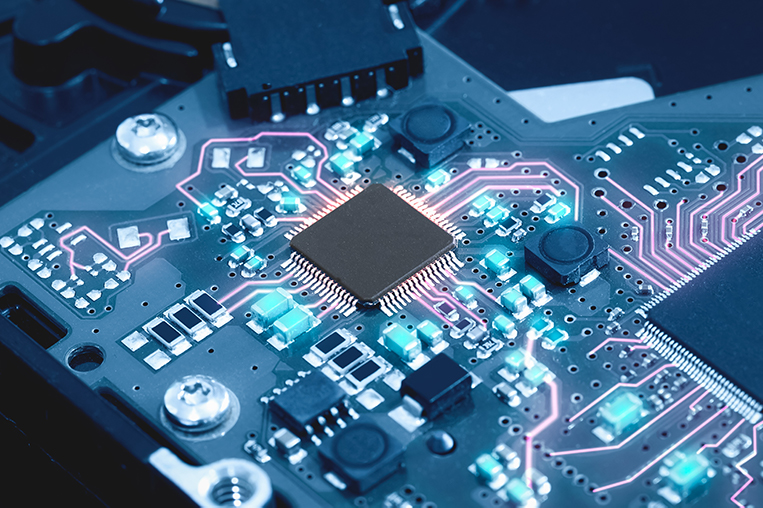Analyses / Observatoire géopolitique du numérique et des technologies émergentes
23 May 2024
Semiconductors Are the Achilles’ Heel of the AI Giants

The ultra-concentration in the design and production of semiconductors for AI, centred around Nvidia and TSMC, is fuelling the interest of digital giants, which are highly dependent in this regard. However, catching up looks to be a difficult task, despite the mobilisation of state actors.
The explosion of artificial intelligence rests on two pillars of a different nature: on the one hand, the development of large language models such as GPT, and on the other, spectacular computing power with dedicated processors. These are designed in particular by the omnipresent giant Nvidia, and manufactured by a tight handful of actors, especially the Taiwanese company TSMC. AI models and semiconductors both require gigantic investments and cutting-edge expertise. However, these are two worlds that, although they cooperate closely, respond to very different requirements.
In terms of model development, American digital giants such as Microsoft, Meta and Google have all the technological, economic and political resources to dominate the sector, both internally and through acquisitions/partnerships. This latter aspect even enables them to domesticate the diversification seen with the explosion of open source, i.e., models that are freely distributed and reusable by anyone. Although open source allows an entire AI ecosystem to exist, it cannot exactly be seen as David’s weapon against Goliath, as the giants themselves are deeply invested in it. Meta’s LLaMa language models are, for example, open source. Moreover, the financial weight and grip of Big Tech are such that we are seeing independent actors being drawn into their orbit one after the other. The French gem Mistral recently announced it was joining Microsoft’s fold, entrusting it with the distribution of its most advanced model, which will therefore be closed. The giants thus have ample means to maintain control over model development.
Nevertheless, behind the domination of these behemoths, the importance of the processors that enable the training of these AI models should not be underestimated. It is in fact the crux of today’s technological warfare and lies in the hands of industrial giants of a different kind. The entire AI scene remains highly dependent on a semiconductor design and production chain that is incredibly concentrated, revolving around Nvidia and TSMC.
A boom in demand for semiconductors dedicated to AI, and very few suppliers
For digital giants, autonomy in terms of semiconductors remains a challenge in which it is difficult to position oneself. After years of investment, Nvidia holds a near-monopoly position in the design of semiconductors dedicated to AI. The American company designed 80% of this type of semiconductor worldwide last year.
Once the design is completed, Nvidia outsources their manufacturing to Taiwan’s TSMC, one of only ten companies in the world capable of producing them. Nvidia is said to be “fabless”. In this industry, manufacturing a semiconductor requires a production line with specific characteristics (manufacturing equipment, testing and packaging). These new production lines are extremely costly. A brand-new factory (or foundry in the sector’s terminology) requires between 15 and 20 billion dollars and a minimum of two years of construction. Very few economic players can invest such colossal sums and overcome the entry barriers to the foundry market (“Fabs”).
States are seizing the issue in the name of technological sovereignty
Despite the enormity of the investments, some actors are entering or returning to this market, such as the American Intel or the Japanese Rapidus. Manufacturers already in the race, like TSMC or South Korea’s Samsung, are continuing to invest in an attempt to maintain their market shares. After the Covid-19 crisis and the subsequent semiconductor shortage, several states decided to relaunch their financial support for the sector. “Chip Acts” have multiplied to increase national semiconductor manufacturing capacity, bolster economic security and guarantee supplies for military use even in times of crisis. Among these countries are the United States in 2022 with the Chips and Science Act ($39 billion), the European Union with the Chip Act (€43 billion in 2023), Japan with the creation of the Rapidus conglomerate and a support plan ($100 billion for Rapidus and new TSMC factories over 2023–2027), China with the launch in 2023 of phase 3 of the Chinese government’s semiconductor fund ($46 billion for 2023–2027), and South Korea with a government plan of $7.3 billion. In the United States, the leverage effect of public subsidies in the sector is noteworthy. The $39 billion of the Chips and Science Act encouraged a wave of private investments amounting to $200 billion, spent by American and foreign companies on American soil.
New entrants and a new scale of financing
Until new factories produce more chips, supply will not be able to meet global demand for AI-dedicated chips. Hence a significant rise in prices. A Nvidia GPU (H100) can cost up to $40,000 per unit. Its availability is limited, because even with increased production volumes, the company still cannot meet market demand. Some users and buyers of Nvidia chips are concerned about being dependent on a single supplier. This is the case for Sam Altman, CEO of OpenAI, because the lack of AI chips risks hindering the development of his own company. Why not try to create one’s own industrial tool to restore this supply-demand imbalance? This is the logic of every new entrant in a booming sector. Sam Altman has been holding numerous meetings with manufacturers and investment funds over the past few months. In his initial estimates, he mentioned a (staggering) investment goal of $7 trillion to build a new segment of the semiconductor industry. The project is still ongoing. And Altman is not alone. Initiatives are springing up. Apple is working with TSMC to manufacture AI chips. The head of the Japanese group SoftBank, Masayoshi Son, wants to turn his group into an AI powerhouse. His latest project is to enable its subsidiary ARM to create a new AI chip division. A prototype will be tested in spring 2025, and mass production should begin in autumn 2025. For its part, Nvidia is maintaining its technological lead in a rapidly growing market. According to the Canadian research centre Precedence Research, the global market is expected to reach $100 billion by 2029 and $200 billion by 2032.
This new type of shortage is prompting digital giants to position themselves in the segment, each in their own way. Faced with these ambitions, Nvidia continues tirelessly to position itself to do even better, notably better than what the giants will probably be able to achieve in designing AI-dedicated processors. The digital giants find themselves caught in an industrial vice that will be difficult to overcome. The prospect of balanced global competition in which all major regions manage to position themselves remains distant and uncertain. Beyond their own interests, the ultra-concentration of AI-dedicated semiconductors highlights a very real risk to industrial resilience across the entire chain, down to end users. In this regard, diversification is a major political issue.
Find out more at the Semiconductor Observatory.

